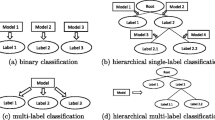Abstract
Before constructing a classifier, we should examine the data to gain an understanding of the relationships between the variables, to assist with the design of the classifier. Using multi-label data requires us to examine the association between labels: its multi-labelness. We cannot directly measure association between two labels, since the labels’ relationships are confounded with the set of observation variables. A better approach is to fit an analytical model to a label with respect to the observations and remaining labels, but this might present false relationships due to the problem of multicollinearity between the observations and labels. In this article, we examine the utility of regularised logistic regression and a new form of split logistic regression for assessing the multi-labelness of data. We find that a split analytical model using regularisation is able to provide fewer label relationships when no relationships exist, or if the labels can be partitioned. We also find that if label relationships do exist, logistic regression with \(l_1\) regularisation provides the better measurement of multi-labelness.
Access this chapter
Tax calculation will be finalised at checkout
Purchases are for personal use only
Similar content being viewed by others
Notes
- 1.
- 2.
All available from http://mulan.sourceforge.net/datasets-mlc.html, https://sourceforge.net/projects/meka/files/Datasets/ (Slashdot), and http://cecas.clemson.edu/~ahoover/stare/ (Stare).
References
Guo, Y., Gu, S.: Multi-label classification using conditional dependency networks. In: IJCAI Proceedings-International Joint Conference on Artificial Intelligence, vol. 22, p. 1300 (2011)
Osojnik, A., Panov, P., Džeroski, S.: Multi-label classification via multi-target regression on data streams. Mach. Learn. 106(6), 745–770 (2016). https://doi.org/10.1007/s10994-016-5613-5
Park, L.A.F., Read, J.: A blended metric for multi-label optimisation and evaluation. In: Berlingerio, M., Bonchi, F., Gärtner, T., Hurley, N., Ifrim, G. (eds.) ECML PKDD 2018. LNCS (LNAI), vol. 11051, pp. 719–734. Springer, Cham (2019). https://doi.org/10.1007/978-3-030-10925-7_44
Park, L.A.F., Simoff, S.: Using entropy as a measure of acceptance for multi-label classification. In: Fromont, E., De Bie, T., van Leeuwen, M. (eds.) IDA 2015. LNCS, vol. 9385, pp. 217–228. Springer, Cham (2015). https://doi.org/10.1007/978-3-319-24465-5_19
Read, J., Pfahringer, B., Holmes, G., Frank, E.: Classifier chains for multi-label classification. Mach. Learn. 85(3), 333 (2011). https://doi.org/10.1007/s10994-011-5256-5
Sucar, L.E., Bielza, C., Morales, E.F., Hernandez-Leal, P., Zaragoza, J.H., Larrañaga, P.: Multi-label classification with Bayesian network-based chain classifiers. Pattern Recogn. Lett. 41, 14–22 (2014)
Zhang, M.L., Zhou, Z.H.: A review on multi-label learning algorithms. IEEE Trans. Knowl. Data Eng. 26(8), 1819–1837 (2014)
Zhang, M.-L., Zhang, K.: Multi-label learning by exploiting label dependency. In: Proceedings of the 16th ACM SIGKDD International Conference on Knowledge Discovery and Data Mining, pp. 999–1008. ACM (2010)
Zou, H., Hastie, T.: Regularization and variable selection via the elastic net. J. R. Stat. Soc.: Ser. B (Stat. Methodol.) 67(2), 301–320 (2005)
Author information
Authors and Affiliations
Corresponding author
Editor information
Editors and Affiliations
Rights and permissions
Copyright information
© 2020 Springer Nature Switzerland AG
About this paper
Cite this paper
Park, L.A.F., Guo, Y., Read, J. (2020). Assessing the Multi-labelness of Multi-label Data. In: Brefeld, U., Fromont, E., Hotho, A., Knobbe, A., Maathuis, M., Robardet, C. (eds) Machine Learning and Knowledge Discovery in Databases. ECML PKDD 2019. Lecture Notes in Computer Science(), vol 11907. Springer, Cham. https://doi.org/10.1007/978-3-030-46147-8_10
Download citation
DOI: https://doi.org/10.1007/978-3-030-46147-8_10
Published:
Publisher Name: Springer, Cham
Print ISBN: 978-3-030-46146-1
Online ISBN: 978-3-030-46147-8
eBook Packages: Computer ScienceComputer Science (R0)





